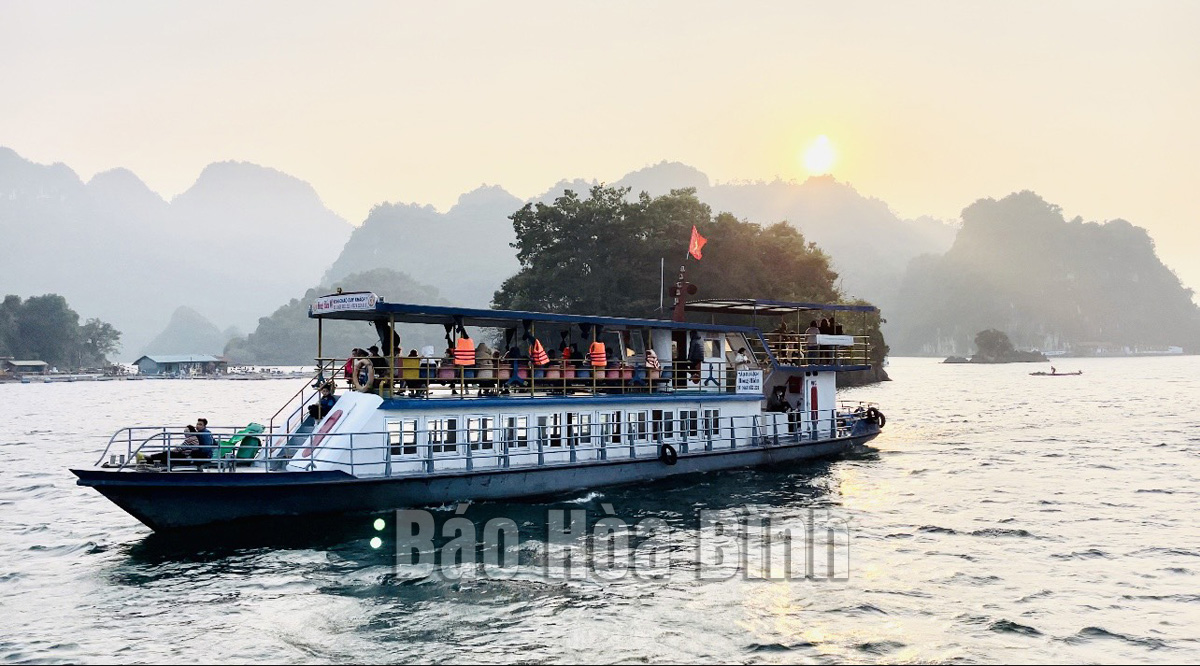
(HBO) – Hoa Binh lake, the biggest man made in Southeast Asia, is about 70km long, crossing 17 communes of one city and five district. It houses 47 large and small islands. The lake area features breathtaking landscapes, enticing cultures of different ethnic groups, and renowned spiritual tourist destinations.
Tourists explore Hoa Binh lake by boat on the Lunar
New Year holiday.
On August 1, 2016, the Prime Minister issued
Decision No. 1528/QD-TTg approving a master plan for developing the lake as a
national tourist area until 2030. On June 22, 2017, the Standing Board of the
provincial Party Committee issued Resolution No. 14-NQ/TU on the development of
the Hoa Binh Lake tourist area into a national one.
After half a decade implementing Resolution No.
14, the province has seen the lake area so far meeting three out of five
criteria set for a national tourist site. Many of its socio-economic
infrastructure projects have been completed, contributing to improving the
conditions of local travel, production and people’s livelihoods.
Currently, the Hoa Binh lake tourist area has
107 accommodation establishments, employing 1,200 workers. Its restaurants,
entertainment spots, tourist attractions, and tours have been built and
connected with localities in the province and country, creating a fairly
diverse tourism ecosystem attractive to visitors.
Every year, the province organises famtrip and
presstrip delegations to invite tourism associations, travel and media agencies
from other provinces to join hands promoting Hoa Binh’s tourism. Other measures
include connecting businesses for partnerships, and expanding tourist markets.
To date, there have been 18 projects worth some 3.5 trillion VND (147.58
million USD) in total approved for investment in the Hoa Binh lake area.
In order to meet remaining criteria for the area
to be recognised as a national tourism site by 2025, Hoa Binh is working to
attract investment projects serving the development of accommodation facilities
rated three stars and above; promoting community-based tourism; tackling investors’
obstacles; and running communications campaigns for raising public awareness on
tourism promotion and environmental protection./.
A Phong Linh (Yellow Tabebuia) flower garden in Thang village, Thach Yen commune, Cao Phong district is currently in full bloom, drawing a large number of visitors.
Community-based tourism has been thriving in Pa Co commune, Mai Chau district thanks to advantages in natural landscape and cultural identity.
Doan Ket commune of Yen Thuy district has recently held a ceremony to receive a certificate recognising Ta communal house as a provincial-level historical and cultural relic site.
In Lac Thuy district, the fertile alluvial land along the Boi River is now home to lush green mulberry gardens, marking the emergence of a new agricultural industry - mulberry cultivation and silkworm farming.
Officially opening in February, Ngoi Hoa Ecotourism Site (PriorBay Resort) in Suoi Hoa commune, Tan Lac district, has quickly become a sought-after destination. It offers visitors a chance to indulge in distinctive and enticing experiences.
Gia Trang Heian Homestay, a unique cultural oasis in the heart of Hoa Binh city, has become a compelling attraction for tourists seeking ethnic cultural experiences within an urban setting. Bui Thi Hien, a local in Kim Boi district with aspiration for ethnic culture and community-based tourism development, created the homestay that seamlessly blends traditional and contemporary features.



